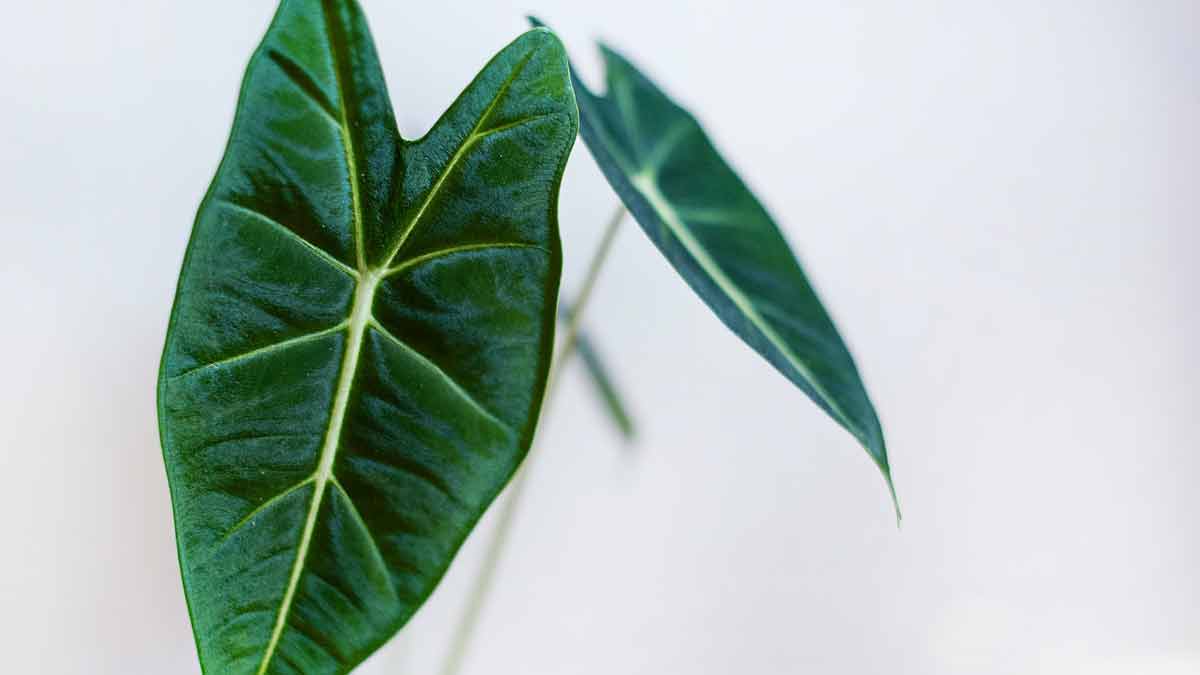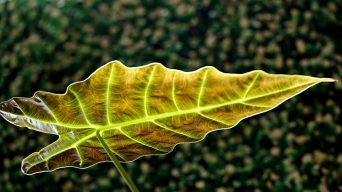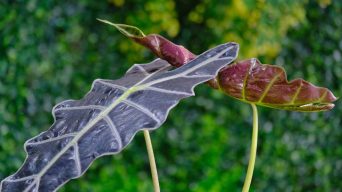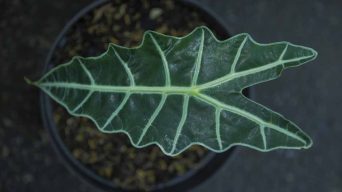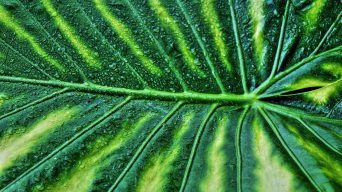Alocasia plants are native to tropical regions and are popular houseplants because of their large, glossy leaves.
While these plants are relatively easy to care for, they can sometimes experience problems, such as drooping leaves.
If your Alocasia leaves are drooping, don’t worry! In most cases, this is a normal and temporary condition easily remedied.
However, there are a few potential causes of drooping leaves to be aware of and some solutions you can try.
Why Are My Alocasia Leaves Drooping?
There are a few different reasons why your Alocasia leaves might be drooping.
Here are some of the most common causes:
1. Underwatering
One of the most common reasons for drooping leaves on an Alocasia plant is underwatering.
These plants need to be watered regularly, about once a week, to prevent the leaves from drooping.
When they are deprived of water, the leaves will start to droop to conserve moisture.
How To Tell If Your Alocasia Is Underwatered
There are a few signs to look for that will help you tell if your Alocasia plant is underwatered:
- The leaves will be drooping and wilted
- The leaves will feel dry and papery to the touch
- The soil will be dry
- The plant will generally look unhealthy
How To Treat An Underwatered Alocasia
If you think your Alocasia plant is underwatered, the best solution is to water it thoroughly.
Be sure to soak the soil and allow the excess water to drain away.
Water your Alocasia plant once a week or when the top inch of soil is dry.
2. Overwatering
Insufficient watering often leads to drooping leaves, but excessive watering can also be a contributing factor.
Alocasia plants can encounter issues if exposed to excessive water, as they are sensitive to overwatering.
The leaves will begin to droop to signal that the plant is getting too much water.
How To Tell If Your Alocasia Is Overwatered
There are a few signs that will help you tell if your Alocasia plant is overwatered:
- The leaves will be drooping and wilted
- The leaves will feel soft and mushy to the touch
- The soil will be soggy or muddy
- The plant will generally look unhealthy
- There may be signs of mold or mildew on the leaves or stems
How To Treat An Overwatered Alocasia
If you think your Alocasia plant is overwatered, allowing the soil to dry out completely is best.
Stop watering your plant and wait for the potting soil to become completely dry before watering again.
Removing any soggy or waterlogged soil from around the plant’s roots is also a good idea.
If the roots are too wet, they may start to rot.
3. Transplant Shock
Transplant shock is another possible reason for drooping leaves on an Alocasia plant.
This usually happens when the plant is moved to a new pot or location and can’t adjust to its new environment.
The leaves will begin to droop as the plant goes into shock.
How To Tell If Your Alocasia Is In Transplant Shock
There are a few signs to look for that will help you tell if your Alocasia plant is in transplant shock:
- The leaves will be drooping and wilted
- The leaves may turn yellow or brown
- The plant will generally look unhealthy
How To Treat An Alocasia In Transplant Shock
If you think your Alocasia plant is in transplant shock, it is best to give it time to adjust to its new environment.
Keep the plant in a warm, bright spot and water it regularly.
The leaves should start to perk up within a few weeks.
4. Too Little Light
Another possible reason for drooping leaves on an Alocasia plant is too little light.
These plants need a lot of bright indirect light to thrive.
Sunlight is essential for the plant to produce food through photosynthesis.
Without enough light, the leaves will droop as the plant starts to starve.
How To Tell If Your Alocasia Is Not Getting Enough Light
There are a few signs that will help you tell if your Alocasia plant is not getting enough light:
- The leaves will be drooping and wilted
- The leaves may turn yellow or brown
- The plant will generally look unhealthy
- The plant may not be growing as quickly as it should
How To Treat An Alocasia Not Getting Enough Light
If you think your Alocasia plant is not getting enough light, the best solution is to move it to a brighter spot.
Find a spot where the plant will get plenty of bright indirect light.
A west- or east-facing window is a good option. This way, the plant will get plenty of light without being in direct sunlight.
5. Lack Of Humidity
Another possible reason for droopy leaves on an Alocasia plant is a low humidity.
These plants prefer high humidity and will start to experience problems if the air is too dry.
The leaves will begin to droop to signal that the plant is not getting enough moisture.
How To Tell If Your Alocasia Is Not Getting Enough Humidity
There are a few signs that will help you tell if your Alocasia plant is not getting enough humidity:
- The leaves will be drooping and wilted
- The leaves may turn brown
- The tips of the alocasia leaves may start to curl
- The plant may stop growing
How To Increase The Humidity For Your Alocasia Plant
If you think that low humidity is causing the leaves on your Alocasia plant to droop, there are a few things that you can do to increase the moisture.
- Place the plant on a pebble tray: Fill a tray with pebbles and water. Place the plant on the tray so that the bottom of the pot is sitting on the pebbles. The water will evaporate and increase the humidity around the plant.
- Mist the leaves: Use a spray bottle to mist the leaves of the plant daily. This will help to increase the humidity around the plant.
- Use a humidifier: Place a humidifier in the room where the plant is located. This will help increase the room’s overall humidity and benefit the plant.
6. Pests
Pests are one of the most common causes of Alocasia leaves drooping.
Aphids, mealybugs, and scale insects are all common pests that can infest Alocasia plants.
These pests suck the sap from the plants, which can cause the leaves to droop. In severe cases, the plant may even die.
How To Tell If Your Alocasia Has Pests
There are a few signs that will help you tell if your Alocasia plant has pests:
- Tiny insects on the leaves or stems
- Sticky honeydew on the leaves
- Black sooty mold on the leaves (the honeydew causes this)
- Yellow, wilted, or distorted leaves
How To Treat An Alocasia Plant With Pests
If you think your Alocasia plant has pests, there are a few things that you can do to get rid of them.
You can remove small infestations by hand. Use a cotton swab dipped in rubbing alcohol to remove mealybugs and scale.
For larger infestations, you may need to use a natural insecticide, such as neem oil or insecticidal soap.
These products are safe to use on Alocasia plants and help get rid of the pests.
7. Root Rot
Root rot is another possible reason for drooping Alocasia leaves.
Root rot is caused by a fungus attacking the plant’s roots.
The roots start to rot and die, which can cause the plant to wilt and the leaves to droop.
In severe cases, the plant may even die.
How To Tell If Your Alocasia Has Root Rot
There are a few signs that will help you tell if your Alocasia plant has root rot:
- The leaves of the plant start to turn yellow or brown and droop
- The roots of the plant are soft and mushy
- The plant may have black spots on the stems or leaves
- The plant may start to produce fewer leaves
- The plant may stop growing altogether
How To Treat An Alocasia Plant With Root Rot
If you think your Alocasia plant has root rot, there are a few things you can do to treat it.
The first thing you need to do is remove the affected roots. Cut away any roots that are soft or mushy.
Next, replant the Alocasia in a fresh, well-draining potting mix.
Be sure to water the plant carefully, as too much water can worsen the root rot.
Finally, treat the plant with a fungicide to help prevent the fungus from spreading.
8. Heat Stress
Heat stress is another possible reason for Alocasia leaves drooping.
Alocasia plants are native to tropical environments and need warm temperatures to thrive.
However, if the temperature gets too high, the plant may start to experience heat stress.
The plant leaves will droop, and the plant may stop growing.
In severe cases, the plant may even die.
How To Tell If Your Alocasia Is Experiencing Heat Stress
There are a few signs that will help you tell if your Alocasia plant is experiencing heat stress:
- The leaves of the plant start to turn yellow or brown
- The leaves of the plant droop
- The plant stops growing
- The plant may wilt
How To Treat An Alocasia Plant That Is Experiencing Heat Stress
If you think your Alocasia plant is experiencing heat stress, there are a few things you can do to treat it.
First, move the plant to a cooler location.
If the temperature is too hot, you may need to move the plant outdoors or to a different room in your house.
Next, increase the humidity around the plant.
You can do this by misting the leaves with water or placing a humidifier in the room.
Finally, don’t place the plant in direct sunlight.
How To Prevent Alocasia Leaves From Drooping?
If you don’t want your Alocasia leaves to droop, you must provide the plant with the proper care.
Here are some tips to follow:
- Make sure the plant is getting enough light. Alocasia plants need bright indirect sunlight to thrive. If your plant is not getting enough sunlight, its leaves will start to droop.
- Water the plant regularly. Alocasia plants must be kept moist at all times but not wet. Allow the top inch of soil to dry out before watering again.
- Use a well-draining potting mix. Alocasia plants are sensitive to overwatering, so it’s essential to use a potting mix that drains well.
- Humidity is important for Alocasia plants. These plants prefer high humidity levels, so be sure to mist the leaves regularly or set the plant on a pebble tray.
- Avoid drafts. Alocasia plants don’t like drafts, so keep them away from doors and windows.
- Don’t let the plant sit in water. Be sure to empty the drip tray after watering and never let the plant sit in water.
- Protect the plant from cold temperatures. Alocasia plants are tropical plants and cannot tolerate cold temperatures. If the temperature dips below 55 degrees Fahrenheit, bring the plant indoors.
These are just a few things you need to do to care for your Alocasia plant.
By following these tips, you can help prevent the leaves from drooping.
Final Thoughts
Alocasia leaves drooping can be caused by several factors, including too much or too little water, not enough light, and pests.
You can prevent droopy leaves by properly caring for your plant and monitoring it for signs of stress.
If your plant’s leaves start to droop, take a closer look at the plant and its environment to determine the cause.
With some care, you can get your Alocasia plant thriving again in no time.

